
TOPIC: What Is The Most Complete Workout For Building A Huge Chest?

The Question:
Building a stronger and bigger chest has many benefits and is often a point of focus for many. Equally important is doing it without injuring yourself.
What is the most complete workout for building a huge chest? Be specific: list complete set, reps, exercises, etc ...
Do you prefer using a barbell, dumbbells or machines? Why?
What should you do to avoid injury during your chest workout?
Bonus Question: What bodybuilder has the most complete package in the chest department?
Show off your knowledge to the world!
The Winners:
- Lynx_Lightning View Profile
- sweatbloodtears View Profile
- History in Effect View Profile
Prizes:
- 1st place - 75 in store credit.
- 2nd place - 50 in store credit.
1st Place: Lynx_Lightning
View This Author's BodySpace Here.
What Is The Best Workout For Building A Huge Chest?
A well developed chest is a staple of a complete physique, and is often emphasized in a workout split. The pectoral muscles are one of the large muscle groups of the body, and as such have a lot of potential, but require focus to hit effectively.
In order to build a wide, complete chest, exercises must be selected that work the chest in isolation and in conjunction with other muscles. Stretch overload and constant tension go a long way toward the development of a wide, striated chest.
Elements Of The Chest Workout
Any pectoral routine would be incomplete without a heavy pressing movement. This will pull supporting muscles into the equation, which triggers a release of anabolic hormones.
In this case, the incline press was chosen. Although weaker than the flat bench press, it puts more stress on the upper pectorals, as opposed to the anterior deltoid, which is prone to overtraining. In this case, two rest-pause sets are used, instead of 3-4 normal sets.
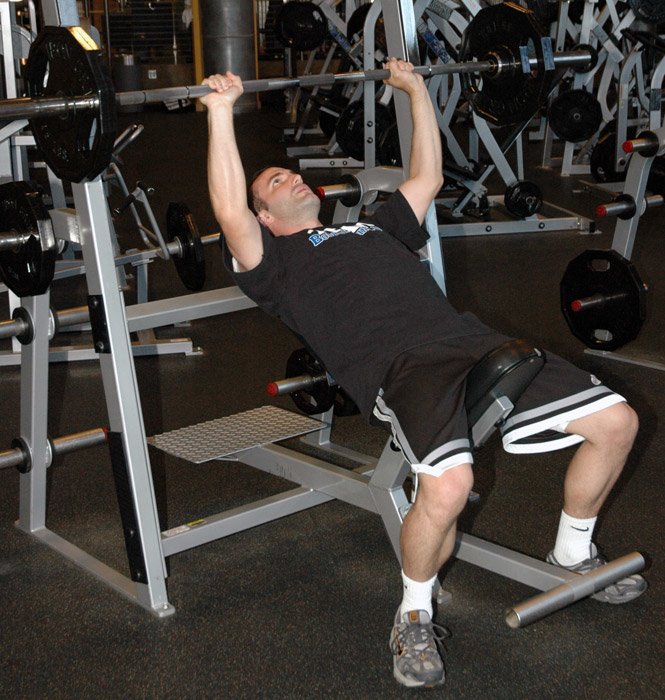
The aim here is to tax the muscles to the limit with heavy weights, which will require the stimulation of the Type II (fast twitch) muscle fibers, which have the greatest potential for growth. The rest-pause sets will extend the length of the time under tension, which will fatigue the Type I (slow twitch) fibers as well, and spur them to growth.
The movement of heavy weights will also help to improve the nerve-muscle connection, which will help stimulate growth. Perform 8-10 repetitions, rack the bar and rest for 20 seconds, and do as many reps as possible, rack the bar yet again, rest 20 more seconds, and do as many reps as possible. This is considered one set.
Rest-Pause Training
This is an advanced technique that allows you to get more reps with the same weight.
- Do a set to failure.
- Rest for 5-to-10 seconds then do a few more reps with the same weight.
- Do this once or a few times depending on your energy levels and how far you wish to push. With this technique you can take a weight you can only do for three reps and do a set of six or more reps with it.
Stretch overload has been shown in studies to increase muscle mass significantly, mostly through hyperplasmia, or an increase in the number of muscle cells present. Stretch overload will also help to develop striations in the pectoral muscles.
The best exercise for activating the stretch overload reflex is the dumbbell fly, as it will leave the muscle fully extended at the end of the eccentric portion of each repetition.
Constant tension has been shown to exclude blood from the muscles during the execution of the exercise, which causes the body to overcompensate afterward and pull excess blood into the muscle (what is known as the "pump").
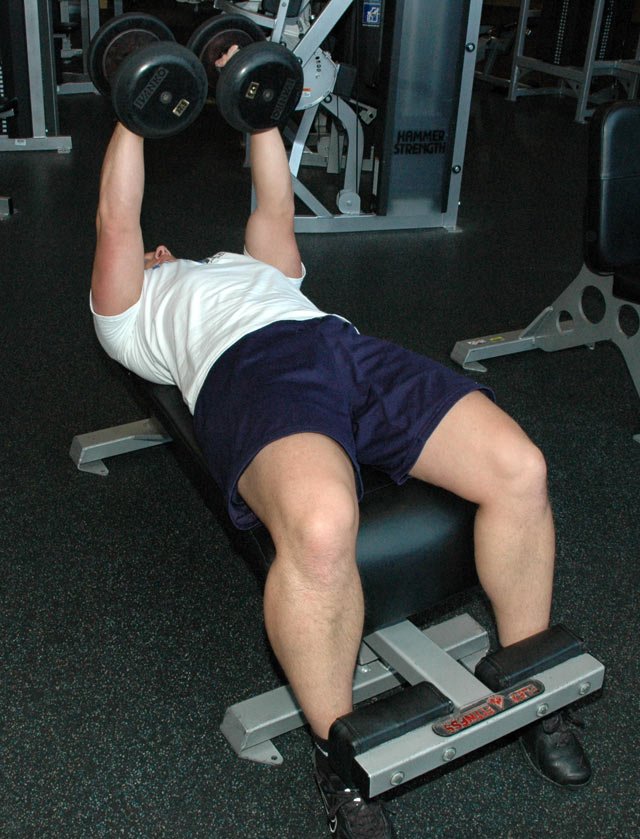
Since muscle is only 1/3 contractile tissue and 2/3 fluid and stored glycogen, this pump will increase muscle size significantly, especially when combined with the progressive overload of the stretch reflex.
Cable flyes or cable presses will keep constant tension on the muscle to accomplish this.
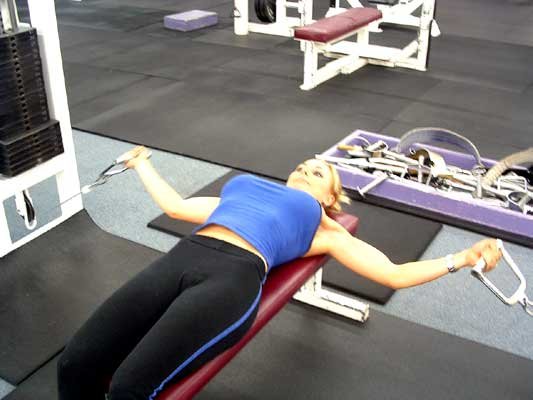
Vince Gironda recommended dips for chest development. Vince Gironda style dips are a good way to isolate the pectoral muscles and apply heavy weight directly to them. However, the dips must be done on a straight bar with a 33" or greater grip, chin tucked to chest, and legs flexed forward slightly at the hips. Otherwise, the triceps and shoulders will be activated as well. This exercise will help to develop the lower part of the pectorals.
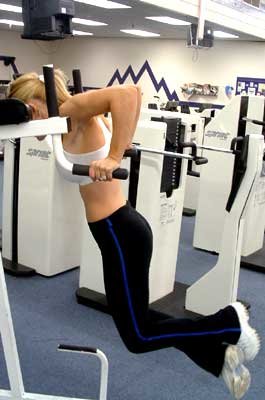
To finish off the workout, do a set of plyometric push-ups (where you launch explosively up on each rep so your hands leave the ground). The quick muscle stretch-shortening cycle involved in this exercise will add a new dimension to growth.
At the end of the workout, it is important to include the often neglected component of stretching, to loosen up the fascia and allow the muscle room to grow. First, grab some dumbbells and position yourself at the starting point of a fly, and allow your muscles to relax. Hold this for 30 seconds for a serious pectoral stretch. Throw in some doorway stretches and across-the-chest arm swings and you are good to go.
Speaking of Vince Gironda, part of building a huge chest is to work the rest of the body to project the illusion of an even larger chest. Remember, no part of the body exists in isolation. A wide back (from pull-ups, rows, pulldowns, etc.), cannonball shoulders (from lateral raises and military presses), and a trim waste (from cardio and abdominal exercises) will project the illusion of a truly impressive chest.
Since no body part exists in isolation, it is advisable to perform other heavy compound lifts, such as squats, deadlifts, cleans, etc. These will stimulate the release of anabolic hormones which will spur muscle growth throughout the whole body.
Sample Workout For The Chest
- Incline Barbell Press: 2 Rest-Pause Sets Starting At 8-10
- Dumbbell Flyes: 3 Sets Of 8-10
- Dips: 2 Sets To Failure
- Cable Flyes: 2 Sets Of 12, Do A Drop Set Or X-rep Set At The End Of The Second Set To Keep Tension On The Muscles
- Push-ups: 1 Set To Failure
 Click Here For A Printable Log Of Lynx_Lightning's Sample Workout.
Click Here For A Printable Log Of Lynx_Lightning's Sample Workout.
Overall, there are 10 sets directed at the chest, which it should handle once per week without risk of overtraining. Add another set of dips if you need more volume, or remove the push-ups and one set of incline presses and dumbbell flyes if you need less.
Do You Prefer Using A Barbell, Dumbbells Or Machines?
Personally, I prefer dumbbells to barbells, as they engage the stabilizer muscles more than either barbells or machines, even though it cuts down on the amount of weight that can be lifted. For really building mass, however, the removal of the stabilizer muscles will allow for heavier lifting and thus more mass gain.
What Should You Do To Avoid Injury During Your Chest Workout?
One of the main causes of injury during any workout regime is a failure to attend to supporting muscles that are designed to protect the body. Bench pressing and other chest exercises place stress on the shoulders and spine, so caution must be taken to avoid overtraining or otherwise injuring these muscles.
A common source of injury in chest training is the shoulders. The anterior deltoid is worked heavily in pressing movements, and can be easily overtrained by the addition of too many front raises and military presses on the shoulder day. When training heavy for the chest, it may be wise to cut front raises from your shoulder workout.
The rotator cuff, a cluster of small muscles around the shoulder joint designed to stabilize and assist the surrounding muscles, is a chronic source of sports injury. It may be wise to train it with forearm adductions and abductions during the light phase of a periodized workout cycle to help prevent injury during the heavy phase.
The deep abdominal muscles are designed to contract and protect the spine during physical activity. Improper form during pressing movements (which should not be a problem) can result in spinal injuries if the abdominal muscles are weak. Any serious workout routine should include sufficient abdominal work to prevent injury.
Of course, proper form is key to injury prevention while exercising. Never lift more than you can handle. The bench press is often used as a marker for how strong a person is, so the amount a person can lift is often embellished.
Pushing movements, such as the bench press, can be dangerous if too much weight is lifted. The eccentric phase of motion must always be performed in a controlled manner, or else injury can occur.
I have personally damaged tendons in my elbow from dropping dumbbells during a press. A spotter is key to not becoming trapped under a weight you cannot lift, and no pressing movement should be done without supervision.
What Bodybuilder Has The Best Package In The Chest Department?
I would have to say that Vince Gironda has the best pectoral definition of any bodybuilder, past or present. He has size, definition and separation. His pectoral muscles continue with their size and definition all the way up to the shoulder. There is a reason he was often considered "too defined."
2nd Place: sweatbloodtears
View This Author's BodySpace Here.
A bigger, thicker, and stronger chest is the goal of nearly every bodybuilder on the planet. Heck, it's a goal for nearly every guy on the planet. Nothing says brawn like a big strong chest. So the question becomes how should somebody go about trying to get it.
Well, the best way to get a huge chest is to hit it hard with a variety of exercises and grips. You have to tax all the fibers in the chest to the max so that it responds and grows. How to do that? Well, I'm here to tell you.
What's The Most Complete Workout For Building A Huge Chest?
The Split
Alternate between a Heavy week and a Not-So-Heavy week.
Week 1: Heavy
In week one the chest is hit with two super intense training sessions to completely tax every part of the chest.
- Sunday: Chest 1
- Monday: Back
- Tuesday: Legs
- Wednesday: Off
- Thursday: Chest 2
- Friday: Shoulders
- Saturday: Arms
Week 2: Not-So-Heavy
In week two the chest is worked only once at medium intensity so that it has ample time to recover for another two brutal sessions in the next week.
- Sunday: Off
- Monday: Back
- Tuesday: Legs
- Wednesday: Chest 3
- Thursday: Shoulders
- Friday: Arms
- Saturday: Off
Workouts In Detail
Chest 1
Focus on overall mass and strength (Make sure to go as heavy as you can and still grind out the required amount of reps).
- Flat Barbell Bench Press: 4 Sets, 12-10-8-6 Reps
- Incline Barbell Press: 4 Sets, 12-10-8-8 Reps
- Smith Machine Flat Bench Press: 4 Sets, 8-8-6-6 Reps
- Weighted Dips: * 4 Sets, 10-10-10-10 Reps
 Click Here For A Printable Log Of sweatbloodtears' Chest 1 Workout.
Click Here For A Printable Log Of sweatbloodtears' Chest 1 Workout.
* After each set strip the weight off and continue to failure.
Chest 2
Focus on upper and middle pecs. (Go as heavy as possible for the given reps).
- Incline Smith Machine Press: 4 Sets, 10-10-8-6 Reps
- Barbell Bench Press: * 4 Sets, 10-8-8-6 Reps
- Machine Incline Press: 4 Sets, 10-10-8-8 Reps
- Machine Flyes (Hold Peak Contraction For 5 Count): 4 Sets, 10 Reps
 Click Here For A Printable Log Of sweatbloodtears' Chest 2 Workout.
Click Here For A Printable Log Of sweatbloodtears' Chest 2 Workout.
* Have rack set somewhat high, so that you place more focus on the end of the bench movement, which focuses more on the inner portion of the pecs. You will probably need to add a bit of weight considering the shorter range of motion. Test the waters with this exercise until you find the right weight for you.
I'd suggest increasing the weight by only 10% from your regular bench press and adding about 5% more after that until you reach the point where you can fail at about 10 reps. Then add a bit more for 8 reps, and again for 6.
Chest 3: Overall Development
Unlike previous two workouts, you'll want to keep the weight at medium intensity. Do a weight where you can do the reps slowly and controlled, without failing at the end.
- Flat Barbell Bench Press: 4 Sets, 10 Reps
- Incline Barbell Press: 4 Sets, 10 Reps
- Flat Dumbbell Press: 4 Sets, 10 Reps
- Cable Flyes: 4 Sets, 10 Reps
 Click Here For A Printable Log Of sweatbloodtears' Chest 3 Workout.
Click Here For A Printable Log Of sweatbloodtears' Chest 3 Workout.
Do You Prefer Using Barbells, Dumbbells Or Machines?
I think it's best to incorporate a mix of the barbells, dumbbells and machines. They each have their advantages and disadvantages. For instance:
- With a machine, you take all the stabilizer muscles out to play and focus slowly on the muscle group you are working. Since you don't have to balance the weight, this allows you to overload the muscles with as much weight as possible.
- Dumbbells on the other hand call more stabilizers into play than normal, thus you can't use as much weight. But working the stabilizers gives you better balance and greater muscle details. And if those stabilizers get stronger, it can help you move more weight in the end.
- Barbells are the best of both worlds. You can go pretty heavy, and still work your stabilizers to a certain degree.
Basically, if you want the best physique possible, you should incorporate all three into your workouts, whether it's chest, back, arms or any other body part.
What Should You Do To Avoid Injury During Chest Training?
For starters, control the weight on the negative. Don't just let it fall. That's a big no no. If you're using barbells, you can crush your rib cage. If you're using dumbbells, you can tear your pecs. Same with a machine. So control the weight at all times. If you can't control the negative, odds are you're using too much weight.
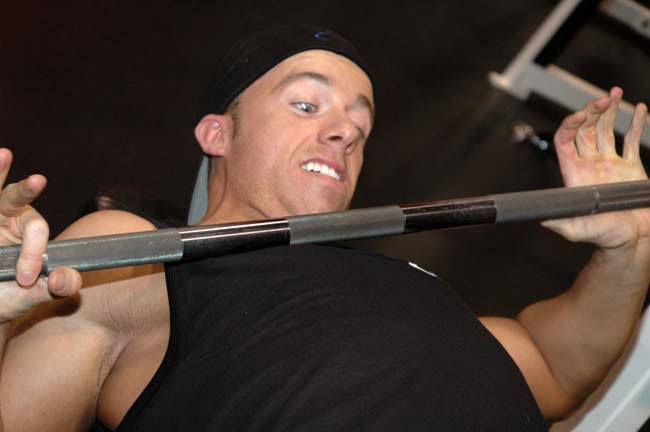
Also, don't let your ego get the best of you. Lift what you can lift. If you can only get 225 for 8 reps, don't go gung-ho and put 265 on the bar to impress people. Sure, you should be able to get maybe 4 reps with that. But when you hit number five, it'll be stuck on your chest and you'll be in serious danger and you'll look like an idiot.
Lastly. Use a spotter. The different bench variations are dangerous. They place large amounts of weight over your head, neck and obviously your chest. If you don't have a spotter to help you as you get tired, you'll be putting yourself in too much danger. And, if you don't have somebody to spot you, sacrifice a little bit of the weight until you can find one.
What Bodybuilder Has The Best Package In The Chest Department?
Well, isn't that just the question of the ages. It really falls down to opinion, and putting the question into greater focus. If you're talking about all time, then my opinion has to be Lou Ferrigno. He had size, detail, thickness and upper and middle peck development. I personally think he had the greatest chest out of any bodybuilder ever.

Now, if you're talking about modern times, I think I'd have to give Johnnie Jackson the nod. He might not be the best bodybuilder around, but his chest is HUGE. Period. It's friggin' massive. They're almost cartoonish in their freakiness.
3rd Place: History in Effect
View This Author's BodySpace Here.
The chest is one of most coveted body parts that bodybuilders want to make sure is dialed in before a contest. Right after curls are bench press which many perform to get bigger and stronger chest. Without a dense and striated chest, a bodybuilder will fail to place in a top position. Every bodybuilder recognizes the need to have a dynamite chest.
What Is The Most Complete Workout For Building A Huge Chest?
- Incline Bench Press: 3x10
- Flat Bench Flyes: 3x10
- Decline Barbell Press: 3x10
- Cable Crossover: 3x10
 Click Here For A Printable Log Of History in Effect's Chest Workout.
Click Here For A Printable Log Of History in Effect's Chest Workout.
Why Three Sets of 10?
It is a good starting place for a beginner who wants to beef up his/her chest and make it stronger. Three sets of 10 is good for strength and a beginner as well as an advanced lifter will experience good gains while doing this routine.
1. Barbell Incline Press
The incline bench press is just as good as the flat bench press, but I like to target my upper pecs more. Some people have the lower and middle pecs from doing flat bench, but they lack upper pecs. I choose to use incline to address my lack of separated upper pecs.

2. Flat Bench Dumbbell Flyes
I choose to add flyes to my arsenal because it helps widen your chest and make it fuller around the outer part of the pecs. Flyes shape those outer pecs to perfection.

3. Decline Barbell Press
I like to work my chest from all angles and by doing decline barbell press I make sure I don't neglect the lower part of my pecs. Many people fail to put this in their workout, but I feel my lower pecs are important in separating it from my upper abs.
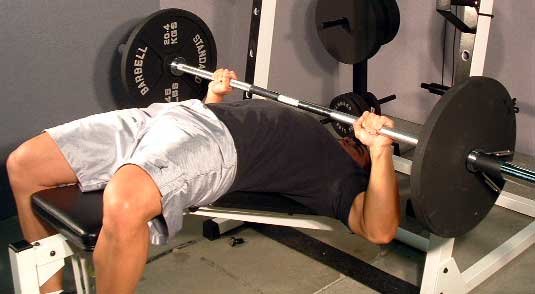
4. Cable Crossover
Cables exercises put the lifter under constant movement and also helps shape whatever body part you doing. If you want definition and striation in your chest, then cable crossover is the way to go.
Arnold and especially Franco Columbu had striated chest from top to bottom.
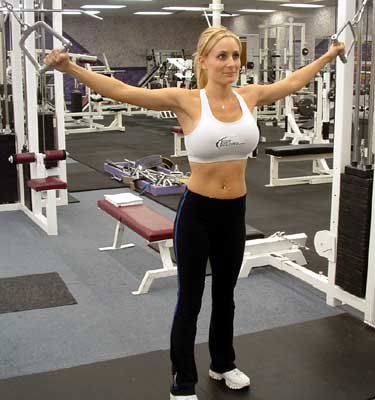
Do You Prefer Using A Barbell, Dumbbells Or Machines?
I prefer switching up things every week and keeping my body fresh. It allows my body to keep growing like it should and not plateau as often. I often add into DB Incline Press or DB Decline Press in exchange for the ones listed.
Dumbbells work my stabilizer muscles and also give me a better stretch allowing me to put on more quality muscles. I do use machines, but usually as quality warm-up sets or when I am taking a weight to failure.
What Should You Do To Avoid Injury During Your Chest Workout?
I make sure and get quality rest between sets. If I am going for conditioning, I will rest between 45-and-60 seconds. If not, I rest between 90-and-120 seconds. I take in water during those rest sets to keep my body functioning at its best.
After chest workouts, I also use hydrotherapy. Hydrotherapy involves alternating between hot and cold water in the shower or bath which allows for recovery and brings more blood into the system. It is useful. Last but not least, keep perfect form and you will be fine. Sloppy form and you might have a pec tear. Form is the key.
What Bodybuilder Has The Best Package In The Chest Department?
This might be the hardest question ever in bodybuilding history. When I think chest, I think of a lot of people. Arnold Schwarzenegger, Franco Columbu, Lee Haney, Ronnie Coleman, Branch Warren, Johnnie Jackson, Markus Ruhl, and so on. I'm old school, so I would go with Arnold according to size and Columbu according to striations and detail in the chest.
